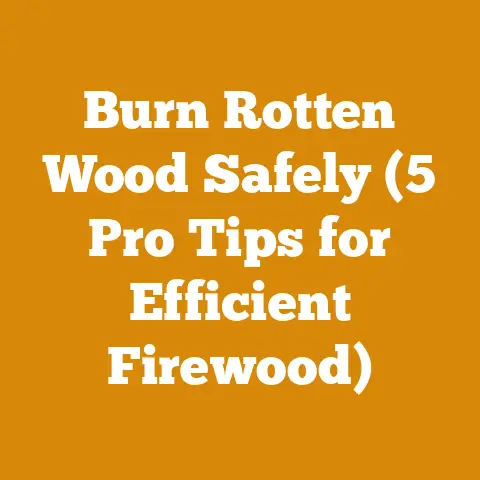Cleveland Iron Works Pellet Stove Review: Ash Buildup Fixes (Pro Tips)
Ah, the comforting embrace of warmth! There’s nothing quite like the radiant heat of a pellet stove on a chilly evening. I still remember the first time I fired up my own pellet stove. The promise of efficient, consistent heat was intoxicating. But, like many others, I soon encountered the dreaded ash buildup, threatening to turn my cozy haven into a frustrating chore. Over the years, I’ve wrestled with ash in countless stoves, learning a thing or two about taming the beast.
This guide is dedicated to understanding and conquering ash buildup in Cleveland Iron Works pellet stoves, drawing from my experience and in-depth research. We’ll delve into the causes, preventative measures, and proactive solutions so you can get back to enjoying the warmth without the worry.
Cleveland Iron Works Pellet Stove Review: Ash Buildup Fixes (Pro Tips)
Understanding the Ash Problem
Ash buildup is a natural byproduct of burning wood pellets. However, excessive ash can significantly impact your Cleveland Iron Works pellet stove’s performance and longevity. It reduces airflow, hinders combustion, and can even damage internal components.
Why Cleveland Iron Works Stoves?
These stoves are generally well-regarded for their efficiency and user-friendly designs. However, all pellet stoves, regardless of brand, are susceptible to ash accumulation. Understanding the specific nuances of your Cleveland Iron Works model is key to effective ash management.
The Culprits Behind Ash Buildup:
- Pellet Quality: This is the BIGGEST factor. Low-quality pellets contain more ash-producing materials like bark, dirt, and additives. I learned this the hard way after buying a “bargain” pallet of pellets one winter. The stove needed cleaning twice as often, and the glass was constantly coated in soot.
- Improper Combustion: Incomplete burning of pellets leads to increased ash and soot. This can be caused by insufficient airflow, a clogged burn pot, or a malfunctioning igniter.
- Stove Settings: Running your stove at low heat settings can sometimes lead to incomplete combustion and more ash.
- Lack of Maintenance: Neglecting regular cleaning exacerbates the problem. Ash accumulates, further hindering airflow and combustion efficiency.
- Ventilation Issues: A poorly ventilated exhaust system can cause back-drafting and contribute to ash buildup within the stove.
Identifying the Severity of Ash Buildup
Before diving into fixes, it’s crucial to assess the extent of your ash problem. This will help you determine the appropriate course of action.
Signs of Excessive Ash Buildup:
- Reduced Heat Output: The stove struggles to maintain the desired temperature.
- Smoky or Sooty Glass: A dark film quickly accumulates on the glass door.
- Visible Ash Accumulation: A thick layer of ash is present in the burn pot, ash pan, and internal components.
- Frequent Flame-Outs: The stove shuts down prematurely due to poor combustion.
- Unusual Noises: Grinding or rattling sounds may indicate ash buildup interfering with moving parts.
- Increased Pellet Consumption: The stove burns through pellets at a faster rate to compensate for reduced efficiency.
- Strong Odor: A persistent smoky or burning smell, even when the stove is operating normally.
A Simple Test:
I often use a simple test to gauge the ash content of my pellets. I burn a cup of pellets in a metal container outdoors. Once cooled, I can visually assess the amount and consistency of the remaining ash. Excessive clinkers or a large volume of fine ash indicates poor pellet quality.
Proactive Prevention: Choosing the Right Pellets
The battle against ash buildup begins long before you even fire up the stove. Selecting high-quality pellets is paramount.
Understanding Pellet Grades:
Pellets are typically graded as Premium, Standard, or Utility. These grades reflect ash content, heat output, and overall quality.
- Premium Pellets: These pellets have the lowest ash content (typically less than 1%) and produce the highest heat output. They are generally made from 100% hardwood.
- Standard Pellets: These pellets have a slightly higher ash content (1-3%) and may contain a mix of hardwood and softwood.
- Utility Pellets: These pellets have the highest ash content (over 3%) and are often made from lower-quality wood sources. I strongly advise against using these in a Cleveland Iron Works stove. The savings are not worth the hassle.
Key Indicators of Quality Pellets:
- Low Ash Content: Look for pellets with a certified ash content of 1% or less. This information is usually printed on the bag.
- High Heat Output: Opt for pellets with a BTU rating of 8,000 or higher. Higher BTU means more heat per pound of pellets.
- Low Moisture Content: Pellets should have a moisture content of 8% or less. Excess moisture hinders combustion and increases ash production.
- Consistent Size and Shape: Pellets should be uniform in size and shape to ensure consistent feeding and combustion.
- Clean Appearance: Pellets should be free of dust, debris, and foreign materials.
- Certification: Look for pellets certified by the Pellet Fuels Institute (PFI). PFI certification ensures that the pellets meet established quality standards.
My Pellet Selection Strategy:
I typically stick with premium-grade hardwood pellets from reputable manufacturers. While they may be slightly more expensive upfront, the reduced ash buildup, improved heat output, and longer stove lifespan more than justify the cost. I also like to try different brands to see how they perform in my stove.
Experimenting with Wood Types:
Different wood types produce varying amounts of ash. Hardwoods like oak and maple generally produce less ash than softwoods like pine. However, the manufacturing process and the presence of bark or other contaminants can significantly impact ash content, regardless of wood type.
Pellet Storage Best Practices:
Proper pellet storage is crucial to maintain their quality.
- Keep Pellets Dry: Store pellets in a dry, well-ventilated area to prevent moisture absorption. Moisture can cause pellets to crumble and produce more ash.
- Elevate Pellets: Store pellets on a pallet or raised platform to protect them from ground moisture.
- Cover Pellets: Cover pellets with a tarp or waterproof cover to shield them from rain and snow.
- Avoid Direct Sunlight: Prolonged exposure to direct sunlight can degrade pellets and reduce their heat output.
Regular Maintenance: The Key to Longevity
Regular maintenance is absolutely essential for preventing excessive ash buildup and ensuring the long-term health of your Cleveland Iron Works pellet stove.
Daily/Every Other Day Tasks:
- Burn Pot Cleaning: The burn pot is where the pellets are burned, and it’s the most common area for ash accumulation. Use a scraper or vacuum to remove ash and clinkers from the burn pot daily or every other day, depending on pellet quality and stove usage.
- Glass Cleaning: Clean the glass door with a stove glass cleaner to remove soot and creosote. A clean glass door allows you to monitor the flame and combustion process.
Weekly Tasks:
- Ash Pan Emptying: Empty the ash pan when it’s about half full. Overfilling the ash pan can restrict airflow and lead to incomplete combustion.
- Hopper Cleaning: Vacuum out any dust, debris, or crumbled pellets from the hopper. This ensures smooth pellet feeding.
Monthly Tasks:
- Vent Cleaning: Inspect and clean the vent pipe to remove any ash or creosote buildup. A clogged vent can restrict airflow and cause back-drafting. I use a specialized vent brush for this task.
- Internal Cleaning: Thoroughly clean the internal components of the stove, including the heat exchanger tubes, combustion chamber, and exhaust passages. A shop vacuum with a narrow nozzle attachment is ideal for this.
- Check Seals: Inspect the door and ash pan seals for any damage or wear. Replace worn seals to prevent air leaks.
- Inspect the Igniter: Make sure the igniter is clean and free of ash buildup. A clean igniter will ensure reliable ignition.
Annual Tasks:
- Professional Inspection: Have your pellet stove professionally inspected and serviced by a qualified technician. A professional inspection can identify potential problems and ensure that your stove is operating safely and efficiently. This is especially important for checking safety components like the high-temperature limit switch.
- Deep Cleaning: Perform a deep cleaning of the entire stove, including the vent system. This may involve disassembling certain components for thorough cleaning.
Maintenance Schedule Example:
| Task | Frequency | Tools Required |
|---|---|---|
| Burn Pot Cleaning | Daily/Every Other Day | Scraper, Vacuum |
| Glass Cleaning | Daily/Every Other Day | Stove Glass Cleaner, Cloth |
| Ash Pan Emptying | Weekly | None |
| Hopper Cleaning | Weekly | Vacuum |
| Vent Cleaning | Monthly | Vent Brush, Vacuum |
| Internal Cleaning | Monthly | Shop Vacuum, Narrow Nozzle Attachment |
| Check Seals | Monthly | Visual Inspection |
| Inspect Igniter | Monthly | Visual Inspection |
| Professional Inspection | Annually | N/A |
| Deep Cleaning | Annually | Shop Vacuum, Various Brushes, Screwdrivers |
Lubrication:
Refer to your Cleveland Iron Works pellet stove’s owner’s manual for specific lubrication recommendations. Some models may require periodic lubrication of certain moving parts, such as the auger motor or blower motor.
The Importance of the Owner’s Manual:
Your Cleveland Iron Works pellet stove’s owner’s manual is your bible. It contains detailed instructions on proper operation, maintenance, and troubleshooting. Always refer to the owner’s manual before performing any maintenance tasks.
Optimizing Combustion: Fine-Tuning Your Stove
Optimizing combustion is crucial for minimizing ash buildup and maximizing heat output.
Airflow Adjustment:
Proper airflow is essential for complete combustion. Insufficient airflow can lead to incomplete burning of pellets and increased ash production.
- Air Intake Adjustment: Some Cleveland Iron Works pellet stoves have an adjustable air intake. Experiment with different settings to find the optimal airflow for your stove and pellet type. Start with the manufacturer’s recommended setting and make small adjustments as needed.
- Combustion Blower Speed: Some models allow you to adjust the combustion blower speed. Increasing the blower speed can improve airflow and combustion efficiency, but it can also increase pellet consumption.
- Check for Air Leaks: Inspect the door, ash pan, and vent connections for any air leaks. Air leaks can disrupt the combustion process and lead to increased ash buildup.
Stove Settings:
Running your stove at the appropriate heat setting is important for optimal combustion.
- Avoid Low Heat Settings: Running your stove at low heat settings for extended periods can lead to incomplete combustion and increased ash production.
- Use Thermostat Mode: If your stove has a thermostat mode, use it to maintain a consistent temperature and avoid frequent cycling on and off. Cycling can lead to incomplete combustion.
Pellet Feed Rate:
The pellet feed rate determines how quickly pellets are fed into the burn pot. Adjusting the feed rate can impact combustion efficiency.
- Consult the Owner’s Manual: Refer to your owner’s manual for instructions on adjusting the pellet feed rate.
- Observe the Flame: Observe the flame pattern. A tall, smoky flame indicates that the feed rate is too high. A small, weak flame indicates that the feed rate is too low.
- Adjust Gradually: Make small adjustments to the feed rate and monitor the stove’s performance.
Burn Pot Design:
The design of the burn pot can also impact combustion efficiency.
- Self-Cleaning Burn Pots: Some Cleveland Iron Works pellet stoves have self-cleaning burn pots that automatically remove ash and clinkers.
- Manual Cleaning Burn Pots: If your stove has a manual cleaning burn pot, be sure to clean it regularly to maintain optimal airflow.
Fuel Trim Adjustment:
Some advanced Cleveland Iron Works pellet stoves have a fuel trim adjustment. This allows you to fine-tune the fuel-to-air ratio for optimal combustion. Refer to your owner’s manual for instructions on adjusting the fuel trim.
Oxygen Deprivation Sensor:
Many Cleveland Iron Works pellet stoves have an oxygen deprivation sensor that shuts down the stove if oxygen levels are too low. This is a safety feature that prevents carbon monoxide poisoning. Make sure the sensor is clean and functioning properly.
Troubleshooting Common Ash Buildup Issues
Even with proper prevention and maintenance, you may still encounter ash buildup issues. Here are some common problems and their solutions.
Problem: Excessive Ash Accumulation in the Burn Pot
- Possible Causes: Low-quality pellets, insufficient airflow, improper stove settings, clogged burn pot.
- Solutions: Switch to higher-quality pellets, adjust the air intake, increase the combustion blower speed, clean the burn pot more frequently.
Problem: Smoky or Sooty Glass
- Possible Causes: Incomplete combustion, low-quality pellets, improper stove settings, clogged vent.
- Solutions: Switch to higher-quality pellets, adjust the air intake, increase the combustion blower speed, clean the vent.
Problem: Frequent Flame-Outs
- Possible Causes: Insufficient airflow, clogged burn pot, low-quality pellets, malfunctioning igniter.
- Solutions: Clean the burn pot, adjust the air intake, switch to higher-quality pellets, replace the igniter.
Problem: Reduced Heat Output
- Possible Causes: Excessive ash buildup, low-quality pellets, improper stove settings, clogged vent.
- Solutions: Clean the stove thoroughly, switch to higher-quality pellets, adjust the air intake, clean the vent.
Problem: Unusual Noises
- Possible Causes: Ash buildup interfering with moving parts, worn bearings, loose screws.
- Solutions: Clean the stove thoroughly, lubricate moving parts, tighten loose screws, replace worn bearings.
Problem: Increased Pellet Consumption
- Possible Causes: Inefficient combustion, air leaks, improper stove settings.
- Solutions: Clean the stove thoroughly, seal air leaks, adjust the air intake, adjust the pellet feed rate.
Using a Multimeter:
A multimeter can be a valuable tool for diagnosing electrical problems in your pellet stove, such as a malfunctioning igniter or blower motor. Refer to your owner’s manual for instructions on using a multimeter to test these components.
Calling a Professional:
If you’re unable to resolve the ash buildup issues yourself, don’t hesitate to call a qualified pellet stove technician. They have the expertise and tools to diagnose and repair complex problems.
Advanced Techniques for Ash Management
For those seeking to take their ash management skills to the next level, here are some advanced techniques.
Using an Ash Vacuum:
An ash vacuum is a specialized vacuum designed for removing ash from pellet stoves. It features a heat-resistant hose and a fine-particle filter that prevents ash from escaping into the air. I find this indispensable for thorough cleaning.
Ash Disposal Methods:
Proper ash disposal is important for environmental reasons and to prevent fire hazards.
- Cooling the Ash: Allow the ash to cool completely before disposing of it. Hot ash can ignite flammable materials.
- Metal Container: Store the cooled ash in a metal container with a tight-fitting lid.
- Disposal Options: Dispose of the ash in a designated ash disposal area, mix it with compost, or use it as a soil amendment (in small quantities, as wood ash is alkaline).
Using Ash as a Garden Amendment:
Wood ash contains valuable nutrients, such as potassium and calcium, that can benefit plants. However, it’s important to use ash sparingly and avoid using it on acid-loving plants. I typically add a small amount of ash to my compost pile.
Modifying Your Stove:
Some pellet stove owners modify their stoves to improve combustion efficiency or reduce ash buildup. However, I strongly advise against modifying your stove without consulting a qualified technician. Modifications can void your warranty and potentially create safety hazards.
Experimenting with Additives:
Some pellet stove owners use additives to improve combustion or reduce ash buildup. However, the effectiveness of these additives is debatable. I recommend researching additives thoroughly before using them in your Cleveland Iron Works pellet stove.
Data Logging:
Data logging involves recording various parameters of your pellet stove’s operation, such as temperature, airflow, and pellet consumption. This data can be used to identify trends and optimize stove performance. Some advanced pellet stoves have built-in data logging capabilities.
Safety First: Protecting Yourself and Your Home
Safety should always be your top priority when operating and maintaining a pellet stove.
Carbon Monoxide Detectors:
Install carbon monoxide detectors in your home, especially near the pellet stove. Carbon monoxide is a colorless, odorless gas that can be deadly.
Smoke Detectors:
Ensure that your smoke detectors are functioning properly and have fresh batteries.
Fire Extinguisher:
Keep a fire extinguisher readily accessible near the pellet stove.
Proper Ventilation:
Ensure that your home is properly ventilated to prevent carbon monoxide buildup.
Regular Inspections:
Have your pellet stove professionally inspected and serviced annually to ensure that it’s operating safely.
Clearance Requirements:
Maintain the proper clearance between the pellet stove and combustible materials, such as furniture and curtains. Refer to your owner’s manual for specific clearance requirements.
Electrical Safety:
Follow all electrical safety precautions when working on your pellet stove. Disconnect the power before performing any maintenance tasks.
Protecting Your Hands:
Wear gloves when handling ash or cleaning the stove to protect your hands from irritation.
Eye Protection:
Wear eye protection when cleaning the stove to prevent ash from getting into your eyes.
Child Safety:
Keep children away from the pellet stove when it’s operating. The stove surfaces can get very hot.
Case Studies: Real-World Examples
Let’s examine a couple of real-world scenarios I’ve encountered to illustrate the principles we’ve discussed.
Case Study 1: The “Bargain Pellet” Disaster
A friend of mine, eager to save money, purchased a large quantity of heavily discounted “utility-grade” pellets. Within a week, his normally reliable Cleveland Iron Works stove was struggling. The glass was constantly black with soot, the burn pot was overflowing with ash, and the heat output was significantly reduced.
- Diagnosis: The pellets were of extremely poor quality, containing a high percentage of bark and other contaminants.
- Solution: He switched back to premium-grade pellets and thoroughly cleaned the stove. The stove immediately returned to its normal performance.
- Lesson Learned: The upfront savings of cheap pellets are quickly negated by increased maintenance, reduced efficiency, and potential damage to the stove.
Case Study 2: The Neglected Vent
Another acquaintance complained that his Cleveland Iron Works stove was producing excessive smoke and struggling to maintain temperature. He had been diligently cleaning the burn pot and ash pan but hadn’t touched the vent system in years.
- Diagnosis: The vent pipe was heavily clogged with creosote and ash, severely restricting airflow.
- Solution: He thoroughly cleaned the vent pipe using a specialized brush. The stove’s performance dramatically improved, and the smoke issue disappeared.
- Lesson Learned: Vent cleaning is an essential part of pellet stove maintenance. Neglecting the vent can lead to serious performance and safety issues.
The Future of Pellet Stove Technology
Pellet stove technology is constantly evolving. Manufacturers are developing new features and technologies to improve efficiency, reduce emissions, and simplify maintenance.
Self-Cleaning Stoves:
Self-cleaning stoves automatically remove ash and clinkers from the burn pot, reducing the need for manual cleaning.
Smart Stoves:
Smart stoves can be controlled remotely via a smartphone app. They also offer advanced features such as programmable thermostats and energy monitoring.
Improved Combustion Systems:
Manufacturers are developing more efficient combustion systems that burn pellets more completely and reduce emissions.
Alternative Fuels:
Researchers are exploring alternative fuels for pellet stoves, such as agricultural waste and biomass.
Advanced Filtration Systems:
Advanced filtration systems can remove particulate matter and other pollutants from the exhaust, improving air quality.
Predictive Maintenance:
Predictive maintenance technologies use sensors and data analysis to predict potential problems and schedule maintenance proactively.
Final Thoughts: Enjoying the Warmth Responsibly
Managing ash buildup in your Cleveland Iron Works pellet stove is an ongoing process. By understanding the causes, implementing preventative measures, and performing regular maintenance, you can keep your stove running efficiently and safely for years to come. Remember, a little effort goes a long way in ensuring a cozy and worry-free heating experience. Now, go forth and enjoy the warmth!






